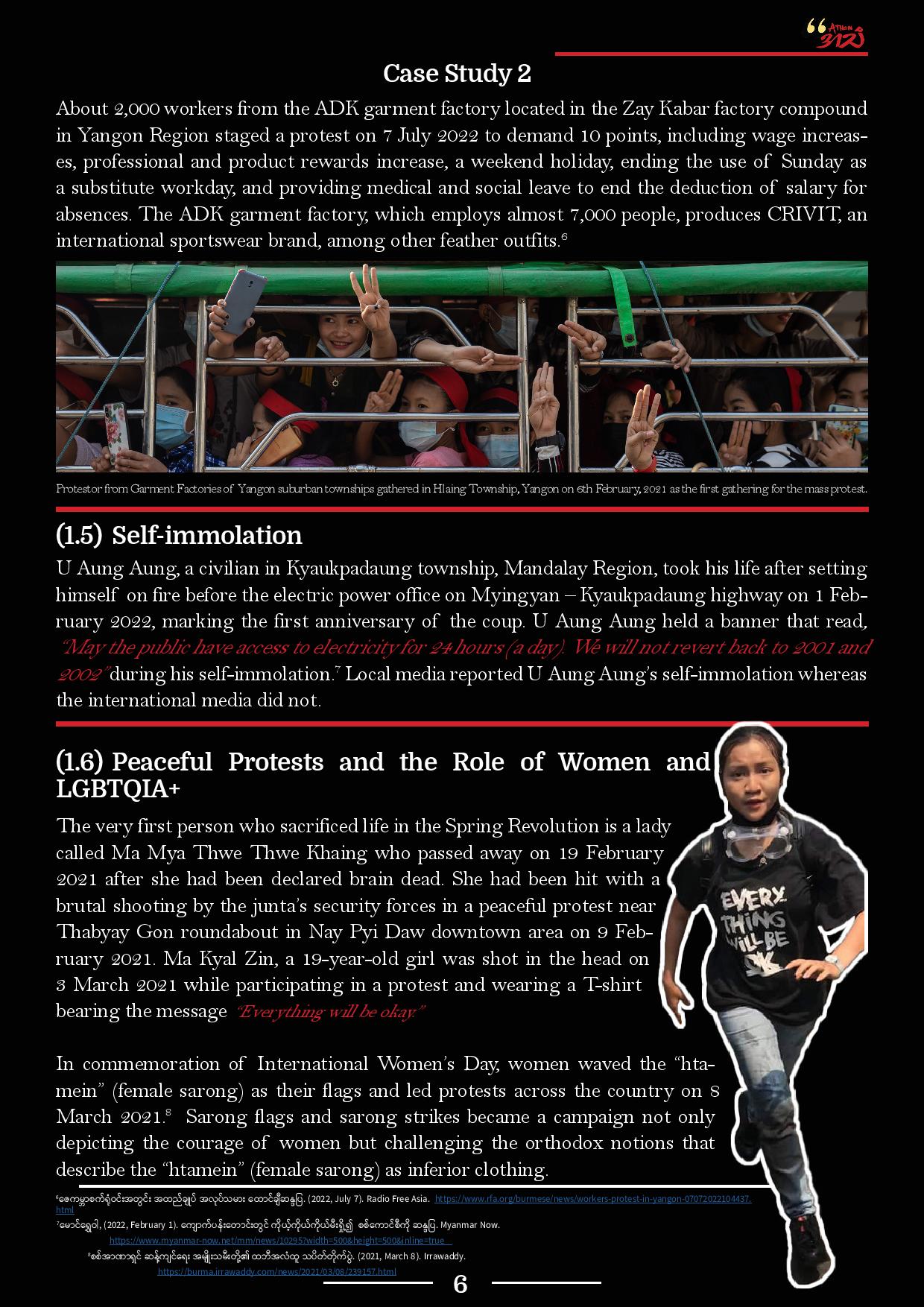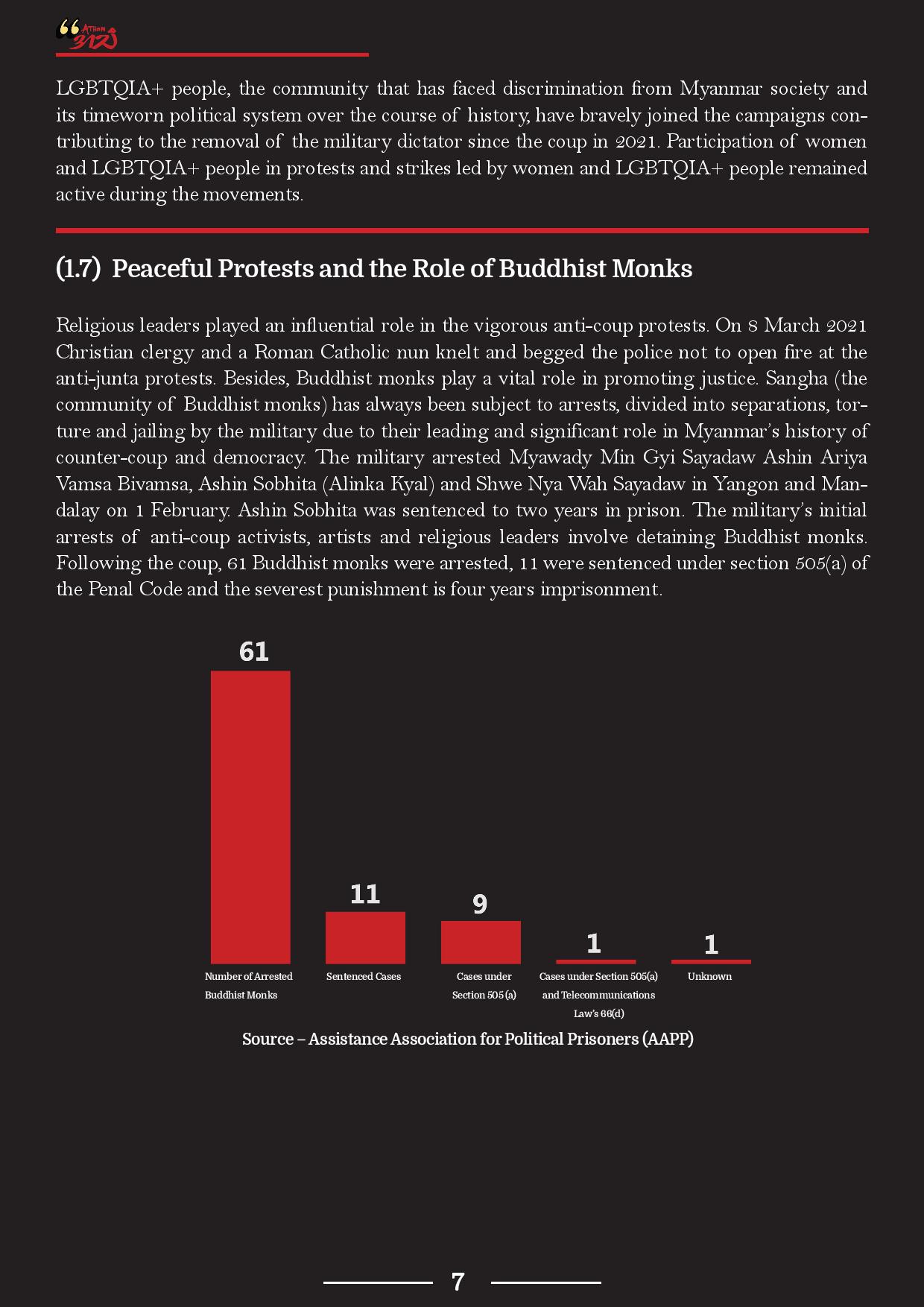where is our right to freedom of assembly?
Executive Summary
- Anti-junta protests constitute 99 % of mass protests, with some socioeconomic protests including protests organized by thousands of garment laborers in the compounds of the Zaykabar company’s factory, strikes of Food Panda riders, PMG bottle refinery factory workers’ strikes calling for the increase of bonus and riots-like pro-military rallies.
- Following the burning of civilian homes, markets, and public property near flash mobs, the military junta has accelerated its tactics to divide the public and strike organisers.
- In total, military and private vehicles were rammed into peaceful protests and struck 19 times, including eight times in Mandalay Region, five times in Yangon Region, three times in Sagaing Region, and once in each of Shan State, Kachin State, and Tanintharyi State.
- Prison strikes include hunger strikes against the junta, prisoner strikes calling for their rights in prisons and strikes showing solidarity with the oppressed outside. Inmate protesters were beaten, kept in solitary confinement, denied access to letters and family, restricted in security, and tortured to death.
- In many cases, the charges against the detained protesters were replaced with more severe offenses. Demonstrators who have been arrested face criminal prosecution under the Penal Code or the Counter-Terrorism Act rather than under the Peaceful Assembly and Peaceful Procession Law, which is less intense.
- The lawyers defending and providing legal assistance to the detained protesters, politicians, and activists were also jailed. A number of young female lawyers providing legal assistance to the detainees have been sexually harassed by both junta forces and police.
- Despite the violent crackdowns and oppression, anti-coup flash mobs have continued to persist in major cities with peaceful protests such as the main strike of Kalay township, Yinmabin Shwewethway strike, the “Our Village Searches No Savior” strike in Yinmabin and multi-village strike of eastern Yinmabin and northern Salingyi Sagaing Region.
Chapter (1)
(1.1) International Standards on Peaceful Assembly
The right to freedom of peaceful assembly is primarily related to the right to freedom of expression. Many international treaties including ICCPR protect the right to peaceful assembly along with the right to freedom of expression. The right to peaceful assembly is crucial as it is the foundation for public-involved governance that is based on democracy, human rights, the rule of law, and pluralism. A government’s failure to respect this right represents a sign of oppression of the public. The right to peaceful assembly takes different forms, including;
- Demonstratioznson or protests
- Meeting
- Various types of strikes
- Assembly or Procession
- Rally
- Online assembly
According to Article 20 of the Universal Declaration of Human Rights (UDHR), everyone has the right to peaceful assembly and peaceful association, while no one is subject to forced participation in any association. Also, Article 21 of the International Covenant on Civil and Political Rights (ICCPR) which guarantees the right to peaceful assembly states, “ The right of peaceful assembly shall be recognized. No restrictions may be placed on the exercise of this right other than those imposed in conformity with the law and which are necessary in a democratic society in the interests of national security or public safety, public order (order public), the protection of public health or morals or the protection of the rights and freedoms of others.”
(1.2) Demonstrations and Protests in Myanmar After the Coup
Protests that erupted in the aftermath of the 2021 coup include rallies, protests, demonstrations, strikes, assemblies and online assemblies and online campaigns. Anti-coup protests constitute 99 % of all protests organized after the coup. Three protests over socioeconomic issues, pro-military rallies, and protest-turned-riots by the pro-junta people were documented.
Civil servants from different fields of the national mechanisms opposed the coup staged by the military in various ways. A pots-and-pans campaign against the military dictator began on 2 Feb-ruary 2021, followed by a Red Ribbon campaign on 3 February 2021.The protests led by Dr. Tayzar Hsan Bagan began in Mandalay on 4 February, followed by pro-tests in Yangon Region and Tanintharyi Region, in the end resulting in massive peaceful protests and campaigns against the military junta that encompassed millions of people across the country. These omnipresent protests across the country prompted the terrorist military to use unproportionate tactics to crack down on peaceful protests by unarmed people. The military then blatantly committed other acts of violence, such as arrests and beatings and firing real bullets at protesters.The analysis indicates that peaceful protests and strikes were still orchestrated by millions of people across the country at the end of March and beginning of April 2021 despite the murders and arrests of peaceful protesters by the brutal junta forces and police officers in March 2021. From 27 March, the protests and strikes in swaths of the countries started to shrink stead turning into flash mobs in cities due to the brutal crackdowns of the military. A strike leader who continues to participate in urban flash mobs said,“We have started to form flash mobs since 29 March after all township sit-ins were cracked down. We started implementing flash mobs on 30 April”.Another strike committee member explained how the flash mobs became, adding that they still continued organizing flash mobs against the coup. “I don’t remember the exact date. But the movements resumed in April for sure. I think it may be 25 or 26 April. We resumed the movement by launching this “Who are we? We are Yangonites” protest in the downtown area of Yangon. Since then, we have organized flash mobs in cooperation with different groups and organizations almost weekly. We are still going strong with the momentum accelerated by the flash mobs on 25 April. Flash mobs are still in Yangon.”
(1.3) Protests-Turned-into-Riots
There were pro-coup rallies and demonstrations as well. Analysis reveals that the political activ-ists who support the military and the Ma Ba Tha branches, widely accepted as the ultranationalist network, led the demonstrations and rallies. In some cases, these rallies and demonstrations take the form of riots as opposed to peaceful demonstrations. As a case study, the pro-military crowd beat two journalists covering a pro-military rally next to Yangon town hall on 1 February 2021, resulting in severe injury to one journalist.
Pro-military protesters holding batons, swords and slingers committed violence toward the by-standers and counter-protesters. As the police demolished the barriers along the streets they marched on, they smashed the windows of the vehicles and looted the vendors. They shot with slingshots at the civilian bystanders when the bystanders counter-protested them by banging pots and pans or showing three finger salutes, forcing the bystanders to stone back at them. As a result, no less than 10 civilians were injured. Furthermore, separate groups of participants re-turning by six buses from a pro-military rally organised in Ayeyarwaddy Region’s Pathein town-ship on 14 February 2021 beat and hit four young people riding motorbikes somewhere on their way as the youths showed them three-finger salutes where they met. Mizzima quoted a pedestrian who witnessed the melee saying, “We were driving back home. About six buses carrying the participants of the pro-military rally stopped next to our car and people from the buses ran and beat the young men with motorbikes. As soon as we stopped, the vehicles drove off. Then a motorbike arrived and two men attacked the boys again. Three boys fled, but one remained. So, the two guys pulled his hair and asked him, “Why did you show three fingers up to us?”.
(1.4) Protests over Socioeconomic Issues
Protests were held only three times between February 2021 and September 2022 regarding socioeconomic issues. These protests were orgazised by Food Panda riders, ADK garment factory workers within the Zay Kabar industrial compound and PMG bottle refinery factory workers.
Case Studies
Case Study 1
Protests were held only three times between February 2021 and September 2022 regarding socioeconomic issues. These protests were organised by Food Panda riders, ADK garment factory workers within the Zay Kabar industrial compound and PMG bottle refinery factory workers.
Food Panda riders embarked on a strike in the middle of March as a response to the cut and exploitation of their wages.The riders demanded eight points:to set 670 Kyat as the minimum wage and increase the wage depending on the distance; to raise the wage based on the levels; to loosen the restrictions controlled by the Software; to take responsibility for any damages and injuries to the riders during working hours; to provide a complete holiday per week; to set not only the distance but the travel on Google Map; to release the company’s announcements on the official social media page and Telegram channels one week in advance; to set a direct hotline number to contact in case of any disputes or issues; to publish ID cards for the riders.
Riders of Food Panda were among those subjected to arbitrary arrests, wrong arrests, beatings, and jailing, with customers’ belongings being looted by junta forces with guns after the coup.


